The COVID-19 lockdown has forced many companies to allow their employees to continue working from home. But this lockdown came without much notice and many of us are not fully prepared to face weeks (if not months) of working from home.
A lot of people will be creating makeshift workstations, using dining room chairs and tables to try and accommodate our daily work life.
While you may not see this as much of an issue, it could in fact be quite detrimental to our overall well-being.
We as employee’s take for granted the equipment that is given to us at our workplaces. We don’t really give it much thought. From ergonomic office chairs to sit/standing adjustable office desks, many of us are not equipped enough at home for this lockdown.
Having a home office is a luxury the vast majority of us will not have. Instead, many have opted for the sofa, dining table, bed or even the floor to continue working.
Sitting like this, scrunched over a tiny laptop for weeks on end, could have serious implications on our back and posture. We really don’t know for sure how long this lockdown may last. As of right now, it’s for the foreseeable.
It’s important, especially in times like these, that we try and avoid anything that could hinder our health. This includes using a dining room chair as a makeshift office chair. Ensuring we maintain a good posture while working is essential to keeping a healthy spine.
Currently, there is no official government mandate to force businesses into buying suitable home office equipment for their workers. But that shouldn’t stop you from being fully prepared yourself. Proper equipment will ease the day-to-day home working lifestyle that has been thrust upon us.
What Not To Do
Do Not Work On The Sofa. While sitting on the sofa with your laptop might sound appealing, in truth it’s possibly the worst place you could sit while working from home. Sofa’s, in general, encourage you to slump. They don’t offer much back support and you’ll end up rounding your shoulders with your head forward. This can put unnecessary strain on our body which will likely lead to back pain.
Do Not Use a Laptop Without a Mouse & Keyboard. The laptop trackpad and keyboard may be useful for on the go working, but working a 9-to-5 job with just that can be detrimental to your posture. The lack of flexibility when it comes to adjusting the computer’s position is likely to make you develop neck and upper back discomfort.
Do Not Use a Dining Room Chair. The dining room may seem like the ideal space for a home office, but dining room chairs are not designed for such prolonged use. They lack any adjustable features to suit you and offer not much in support of your back, neck and arms.
What To Do
Familiarise Yourself With What ‘Proper’ Posture Is. Your feet should be flat on the ground, directly under your knees. Your legs should form right angles. At all costs, avoid having your feet dangle from the chair. This tells you that your chair is too tall for you.
Your spine is very delicate and a lifetime of improper sitting will result in a lifetime of pain. Many people, without realising, will hunch forward while typing on a computer. Be mindful of how you position your body. Bring your abs in toward your spine, lifting your chest then rolling back your shoulders. Your lower back should sit flush with the lumbar support of your office chair.
Afterward, position your head so that your chin is over your sternum, not forward over your body. Finally, maintain a 90-degree angle with your elbows so that they are bent at your sides and your forearms are stretched out in front of you onto your computer or work surface. Having an office chair with adjustable arms can help greatly with this.
The image above should help you understand how you should be sitting while working at a desk with a computer.
Invest In A Proper Ergonomic Chair. Ergonomic Chairs are designed specifically to adapt to an individual’s needs. Whether this is seat height, pan depth, backrest height, back angle, seat tilt, lumbar support or more, ergonomic chairs have the features to help keep you comfortable throughout the working day.
Last month we published an article listing the ‘best ergonomic office chairs for working from home’. As an employee of ChairOffice, I have sat on a Chiro Plus chair for years and I wouldn’t have it any other way. Approved by a UK Chiropractic Doctor, the Chiro Plus ticks all the boxes.
For more on how an ergonomic office chair can benefit you, read our ‘Ergonomics of a Chair Explained’ guide.
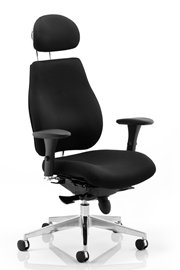
Chiro Plus Black Fabric Ergonomic Office Chair

Ergo Click Plus Fabric Office Chair
Consider A Height Adjustable Desk. There’s been a lot of widespread concern from health officials about the impact of sitting and that we should try and sit less.
Many of us spend the majority of our working day sat down, then tend to use our free time in the evening to watch TV, read books and play games.
It’s a tough ask to always be mindful of our posture as we sit throughout the day. To help alleviate that thought process, consider using a height-adjustable desk. These enable you to stand while you work at a desk and come with incredible benefits.
A study in 2011 published by the CDC showed that after just 4 weeks upper back and neck pain was reduced by 54%.
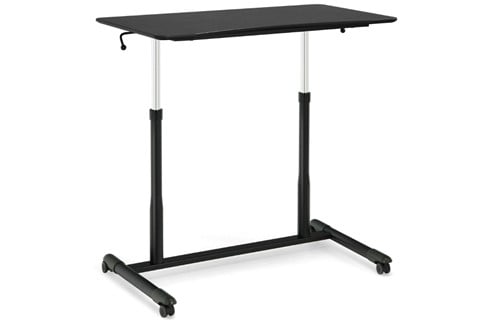
Bancroft Height Adjustable Desk
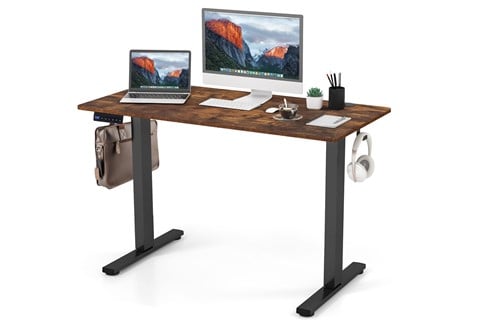
Bradville Height Adjustable Desk
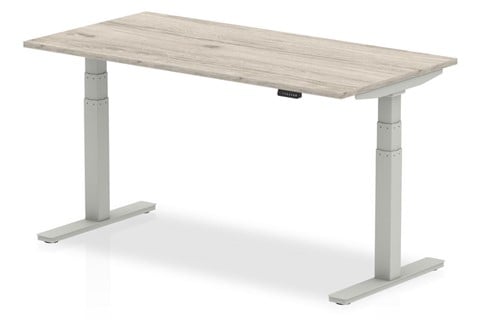
Gladstone Height Adjustable Desk
Move Frequently. If using an office chair, remember to stand up and move about frequently. Ideally, you will want to stand up at least once every hour.
Take this time to incorporate some light exercise to help keep your body from seizing up. If needed, set an alarm on your phone or computer to remind you to take a quick break and get about moving.
The highly-rated ‘Stand Up!’ app on iPhones has been specifically made to help remind you to move about. You can set up a schedule far in advance so it fits your entire work week.
Look At Alternatives. Kneeling chairs offer a complete alternative to the more traditional office chair. At a fraction of the price, a kneeling chair offers all the benefits of what an office chair can offer.
There is a misconception surrounding kneeling chairs that they cause discomfort in the knees. However this is untrue and you’ll find your weight is divided between your spine, thighs and shins as you sit/kneel. Not so long ago, an employee of ours tested out one of our kneeling chairs in a bid for comparison between a traditional office chair and a kneeling chair. Here are her findings.
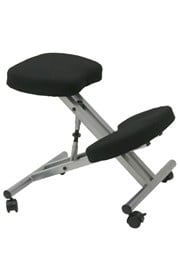
Posture Max Steel Kneeling Chair

Ergonomic Kneeling Stool
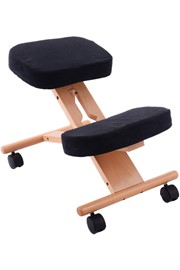
Ergo Wooden Kneeling Stool
Latest Blog Posts

What is a Noticeboard? A Comprehensive Guide
Posted on 19/03/2025
36 Office Etiquette Rules to Follow for a Better Workplace
Posted on 27/02/2025
History of The Office Chair: Who Actually Invented It?
Posted on 26/02/2025
9 Simple Ways To Make Your Office Chair More Comfortable
Posted on 20/01/2025

